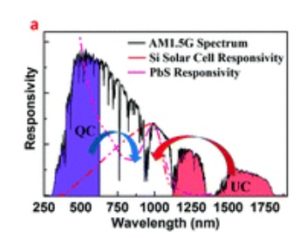W Shao, G Chen, TY Ohulchanskyy, C Yang, H Agren… – Nanoscale, 2017
Photon management enables the manipulation of the number of input photons by conversion of two or more light quanta into one (upconversion) or vice versa (quantum cutting). Simultaneous realization of both these processes in a single unit provides unique opportunities of efficient utilization of photons throughout a broad spectral range. Yet, concurrent realization of these two parallel optical processes in one single unit remains elusive, limiting its impact on many existing or possible future applications such as for panchromatic photovoltaics. Here, we describe an epitaxial active core/inert shell/active shell/inert shell fluoride nanostructure to implement upconversion and quantum cutting within spatially confined and isolated rare-earth-doped active domains. The core area transforms infrared photons through trivalent erbium (Er3+) ions into three- and two-photon upconverted visible and near infrared luminescence, while the second shell domain splits an excitation photon into two near infrared photons through cooperative quantum cutting from one trivalent terbium ion (Tb3+) to two trivalent ytterbium ions (Yb3+). The inert layer in between the active domains is able to effectively suppress the destructive interference between upconversion and quantum cutting, while the outermost inert shell is able to eliminate surface-related quenching. This design enables the colloidal core/multishell nanoparticles to have an upconversion quantum yield of ∼1.6%, and to have a luminescence yield of the quantum cutting process as high as ∼130%. This work constitutes a solid step for flexible photon management in a single nanostructure, and has an implication for photonic applications beyond photovoltaics.

… radiation. The 2θ angle of the XRD spectra was recorded at a scanning rate of 5°/min. Upconversion emission spectra in the range of 480-1100 nm were recorded using an BLUE-Wave fiber spectrometer (Stellar Net Inc.). Laser …





